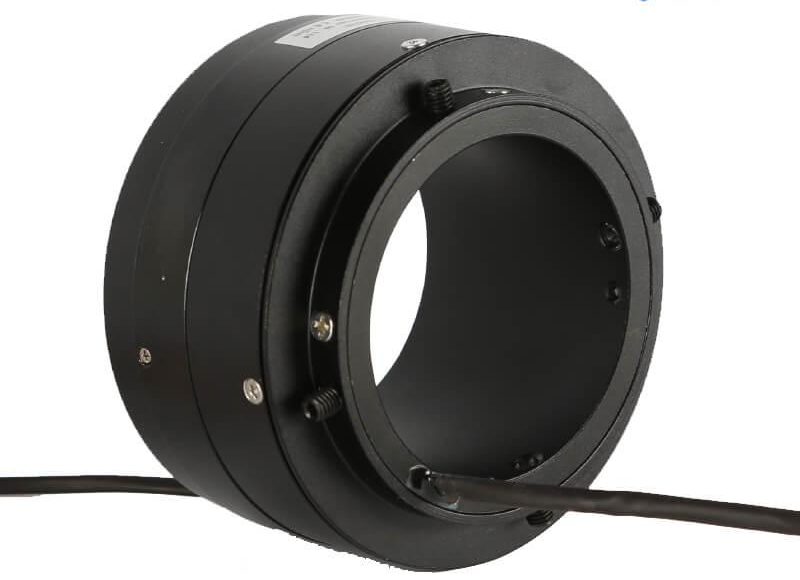Slip rings, also known as rotary electrical joints or electrical rotary unions, and these slip rings are usually made of conductive materials that allow the transmission of electrical power and signals. The specific materials used to make a slip ring will depend on the specific requirements and application of the slip ring.
What Are Slip Rings Made Of
Slip rings are made up of materials like:
Copper: Copper is a highly conductive material that is commonly used to make slip rings. It is strong and durable and has a high melting point, making it suitable for use in high-temperature applications. Copper slip rings are commonly used in applications where high current or power needs to be transmitted, such as in wind turbines and large motors.
Aluminum: Aluminum is a lightweight, highly conductive material that is commonly used to make slip rings. It is corrosion-resistant and has a low melting point, making it suitable for use in low-temperature applications. Aluminum slip rings are commonly used in applications where low current or power needs to be transmitted, such as in medical equipment and robotics.
Brass: Brass is a conductive material that is made up of copper and zinc. It is strong and durable and has a high melting point, making it suitable for use in high-temperature applications. Brass slip rings are commonly used in applications where high current or power needs to be transmitted, such as in wind turbines and large motors.
Carbon: Slip rings are usually made up of carbon, especially brush slip rings. It is strong and durable and has a high melting point, making it suitable for use in high-temperature applications. Carbon slip rings are commonly used in applications where high current or power needs to be transmitted, such as in wind turbines and large motors.
In addition to these materials, slip rings are made of other components too, such as bearings, seals, and insulation materials, to help ensure their proper functioning and reliability. So it is quite evident what slip rings are made of. But have you ever wondered what happens if you use something apart from the normal slip ring material? Here is your answer.
It is generally not recommended to use rubber as a material to make a slip ring. Rubber is not a conductive material, so it cannot transmit electrical power or signals. In addition, rubber is not a durable material and may not withstand the high pressures and temperatures that slip rings are subjected to in many applications.
Therefore, a slip ring is made up of conductive materials, such as copper, aluminum, brass, and carbon, which allow the transmission of electrical power and signals. These materials are strong, durable, and resistant to wear and tear, making them suitable for use in a wide range of applications. Among them, the well-known ethernet slip rings have the advantages of reliable transmission, no packet loss, no serial code, low return loss, and low insertion loss.
If a slip ring is made of rubber, it will not be able to transmit electrical power or signals and may not function properly. It is important to use the appropriate materials for the specific application and requirements to ensure the proper functioning and reliability of the slip ring.
The price of manufacturing a slip ring will depend on several factors, including the type of slip ring, the materials used, the design and production method, and the quantity being produced. Some other factors that can affect the price of manufacturing a slip ring include the specific requirements and specifications of the slip ring, the level of customization, and the level of complexity.
In general, brush slip rings tend to be less expensive to manufacture than brushless or fiber optic slip rings. Multi-channel slip rings and customized slip rings may also be more expensive to manufacture than standard slip rings. Ultimately it all comes down to the materials slip rings are usually made of.
It is difficult to provide a specific price estimate for manufacturing a slip ring without more information about the specific requirements and specifications of the slip ring. It is recommended to consult with a manufacturer or supplier of slip rings to get a more accurate price estimate
Expertise Required to Manufacture Slip Rings
Creating a slip ring requires a high level of technical expertise in electrical engineering, mechanical engineering, and materials science. It involves designing, prototyping, and testing the slip ring to ensure that it meets the specific requirements and functions properly. To make a slip ring, the following technical expertise may be required:
Electrical engineering: Slip rings are used to transmit electrical power and signals between stationary and rotating components. Therefore, a good understanding of electrical principles and electrical engineering is necessary to design and manufacture slip rings.
Mechanical engineering: Slip rings are subjected to high pressures and temperatures and may experience wear and tear over time. Therefore, a good understanding of mechanical engineering principles, such as stress analysis and fatigue analysis, is necessary to design and manufacture slip rings that are able to withstand mechanical loads and stresses.
Materials science: The materials used to make slip rings should be appropriate for the specific application and requirements. A good understanding of materials science principles, such as the properties of different materials and the effects of temperature and corrosion, is necessary to select the appropriate materials for the slip ring.
It is important to note that creating a slip ring can be a complex process that requires specialized knowledge and expertise. It is recommended to seek the help of professionals or consult with a manufacturer that specialized in slip rings to ensure that the slip ring is designed, prototyped, and produced properly. And we’re one of the pioneers in offering high-quality products and services for the same.
That’s for today’s article about what slip rings are usually made of. We’ll be back with another fascinating article soon. Stay tuned.
See What We Can Do

